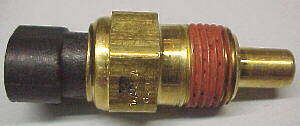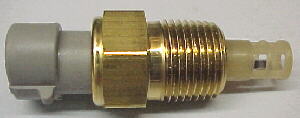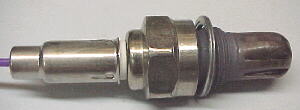| What's Hot! | Products/ Tools | EFI Tuning | Basic Tuning | Advanced Tuning | Chassis Tuning | Advertise with us |
Sensor Inputs
Most EFI systems measure the same basic 6 inputs;
RPM
Most systems measure rpm off of the ignition coil tachometer pulse or crank triggered magnetic/Hall effect sensors. Rpm is considered a primary input signal on all EFI systems. Most systems generate an injection pulse for every tach pulse so as rpm is increased, the frequency of injection pulses is also increased.
Airflow
On mass airflow type systems, this input is also considered a primary input signal. X amount of air requires Y amount of fuel. As rpm and throttle opening is increased, airflow increases to a point.
Manifold Pressure
On speed density type systems, this input is essential when combined with the rpm signal to calculate airflow. As the throttle is opened, the manifold pressure increases which will require more fuel.
Throttle Position
This input is a secondary input on most systems. It is required mainly for acceleration enrichment when the throttle is rapidly opened. By looking at the rate of change of throttle blade angle, the computer can determine how quickly the throttle is being opened and can supply the extra fuel required momentarily to alleviate the lean condition. Throttle position is measured by a potentiometer attached to the throttle shaft. Think of the TPS input as acting like the accelerator pump on a carburetor.

Throttle Position Sensors (TPS)
Some systems can use blade angle instead of manifold pressure for load information. This method is frequently employed on racing engines with hot camshafts and 1 throttle plate per cylinder where the use of a MAP sensor is difficult.
Water Temperature
Water temperature is a secondary input required mainly to ensure proper starting and warmup of the engine. When the engine is cold, the air to fuel ratio must be very rich to enable enough fuel to vaporize for proper starting. The computer increases the injector pulse width to supply extra fuel when cold and tapers this fuel off as the water temperature increases. Once the water warms past 120 degrees or so, the computer does not need to add any extra fuel.

Water Temperature Sensor
Where a carburetor chokes off air to richen the mixture when cold, EFI squirts in extra fuel to achieve the same effect.
Air Temperature
This is a secondary input required especially on speed density systems. The sensor is usually mounted in the intake manifold or air filter area. As the air temperature drops, its density increases. Denser air requires more fuel. As the temperature of the inducted air increases, the computer reduces the pulse width to compensate for lower density. Mass airflow systems are not critically affected by operation without an air temperature sensor because the airflow meter is already measuring the air mass entering the engine.

Air Temperature Sensor
Oxygen Sensor
This sensor is employed in closed loop systems to modify the basic pulse width after the fact. It is mounted into the exhaust manifold area. By looking at the oxygen content of the exhaust gasses after combustion, the computer can determine if the air/fuel ratio is too rich or too lean for optimum combustion and adjust the next few injections accordingly. This sensor is primarily employed for emission control and to a lesser degree, fuel economy. For the lowest average emissions, the air/fuel ratio must be kept around 14.7 to 1.

Oxygen Sensor
Under full throttle conditions, this sensor input is ignored by the computer so that the engine can produce more power by runner a richer mixture. This is called open loop mode and the computer is supplying the injector pulse width from tables based on all of the other sensor inputs. Once throttle opening and rpm are reduced to cruising conditions, most systems will jump back into the closed loop mode where they will stay for a large portion of the time on most street driven applications.
Page 3/4
ATTENTION READER:
If you enjoyed the information and article you just read be sure to check out our newly released book with even more exciting photo's and information:How to Turbocharge and Tune your Engine

Want to know more about your particular Make and Model vehicle? All of these vehicles are covered in the tech, maintenance and repair articles found above. Enginebasics is the wiki or wikipedia of car part, repair, how to and tuning information. Let us be the class 101 for your automotive learning.
| Ford | General Motors GM | Pontiac | Jaguar | Land Rover | Nissan |
| Toyota | Honda | Lexus | Acura | Lotus | Scion |
| Infinity | BMW | Mercedes | Mitsubishi | Ferrari | Maserati |
| Lamborghini | Volks Wagen VW | Saab | Audi | Hyundai | Kia |
| Subaru | Mazda | Chevy | Volvo | Caddilac | Dodge |
| Chrylser | Daewoo | Porsche | Mercury | Freightliner | MG |
Individual Models
| Ford Mustang | Mitsubishi Eclipse | Mitsubishi Evo | Subaru WRX / STI | Dodge Viper | Chevrolet Corvette |
| Nissan Skyline | Honda S2000 | Nissan 350z | Toyota Supra | Chevy Camaro | Lotus Elise Exige |
| Honda Civic | VW Golf | Dodge SRT-4 | Eagle Talon | Acura Integra | BMW M3 |
| Nissan 240sx | Porsche 911 | Acura NSX | Honda Accord | Toyota Camry | Toyota MR2 |
| VW R32 | Dodge Truck | Mazda Rx7 | VW Jetta | Sand Buggy | Nissan Sentra |
For the latest Automotive news and stories visit the websites below |
Our feature Build: An AWD V6 Civic






